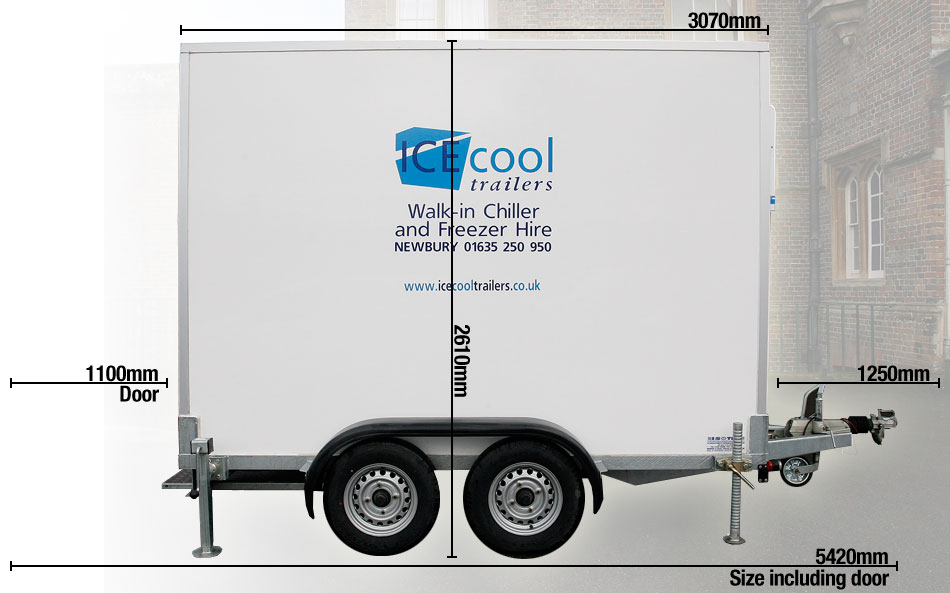Ammonia As Refrigerant For Cold Storage: Is It Safe?

Normally our blog posts deal with the practical aspects of trailer and walk-in chiller hire from Icecool Trailers, but this post is a bit different. Rather than explaining the advantages of refrigerated trailer hire over refrigerated vans, we want to talk about something that could have a very real impact on our industry in the near future: the introduction of ammonia as the main refrigerant for commercial units.
At the current time, almost all commercially available refrigerated trailers and walk-in chillers utilise either CFCs or HCFCs. As you know, governments across the European continent have been working hard to eliminate the use of both, and hope to reduce the environmental impact of commercial refrigeration in doing so.
The problem with their plan is coming up with a different refrigerant that is as effective but without the environmental risks. Ammonia is one possible solution, and is in fact, it is the most talked about solution being discussed at the current time. Ammonia is not new as a refrigerant, but it has not been used on a wide scale thanks to the availability of CFCs and HCFCs. That could change very soon. But what does this mean when it comes to reliable cold storage solutions in the UK?
Advantages of Ammonia
Ammonia has to be a good refrigerant if it is going to replace CFCs and HCFCs. So, how does it stack up? Well, consider the following advantages:
- An ammonia-based system is up to 20% less costly to build
- Ammonia is up to 10% more efficient as a refrigerant than CFC
- Ammonia is less expensive than both CFCs and HCFCs
- Ammonia's ODP and the GWP ratings are both zero, making it absolutely safe for the environment.
From a business perspective, the financial savings ammonia affords are hard to ignore. Manufacturers spend less time building ammonia systems while end-users spend less to run them. It is a win-win for everyone involved. However, ammonia is not a perfect solution and it does have its disadvantages.
Disadvantages of Ammonia
Though there are only two disadvantages to using ammonia, they cannot be ignored. The first disadvantage is that ammonia does not play well with copper pipes. This requires finding a different material that could have a measurable impact on how refrigeration systems are designed.
The second disadvantage is that ammonia is toxic in high concentrations. That's why ammonia spills often lead to mass evacuations. But proponents of ammonia as a refrigerant say the amount of the chemical necessary to run a commercial walk-in chiller would be mostly harmless, especially since ammonia's distinctive smell would warn people to vacate in the event of a leak. Furthermore, ammonia dissipates into the air very quickly.
Mitigating Ammonia's Impact in Mobile Refrigeration
Safety Measures

When using ammonia as a refrigerant, safety is paramount due to its toxicity in high concentrations. To mitigate risks, it is essential to implement rigorous safety protocols. This includes regular maintenance checks, ensuring proper ventilation in storage areas, and installing ammonia detectors that can alert personnel to any leaks. Emergency response plans should also be established to ensure quick evacuation and containment in the event of a spill.
Alternative Materials
As we mentioned, one of the main disadvantages of ammonia is its incompatibility with copper pipes. To address this issue, refrigeration systems must be designed with alternative materials that are resistant to ammonia. Stainless steel and certain types of plastics are viable options that do not react with ammonia, thereby ensuring the longevity and efficiency of the refrigeration system.
Training and Education
Proper training and education for personnel handling ammonia-based refrigeration systems are crucial. Staff should be well-informed about the properties of ammonia, the potential hazards, and the correct procedures for handling and responding to leaks. Regular training sessions and drills can help ensure that everyone is prepared to manage ammonia safely and effectively.
If you want to know more about how refrigerant prices can impact mobile refrigeration rentals, take a look at our blog here.
Environmental Considerations
While ammonia has a low environmental impact compared to CFCs and HCFCs, it is still important to manage it responsibly. Proper disposal methods for ammonia and related waste materials should be in place to prevent environmental contamination. Additionally, investing in ammonia refrigeration systems that are designed to minimise leakage and maximise efficiency can further reduce any potential negative impact on the environment.
The Bottom Line
To conclude, there is little argument that tomorrow's commercial walk-in chillers will not be powered by CFCs or HCFCs. The only question is what will take their place, and right now, all bets are on ammonia. In short, this means that those using mobile cold room rentals need to be knowledgeable of its risks, downsides, and how to make it work long-term - not just for the planet, but for those whose livelihoods depend on mobile refrigeration.



